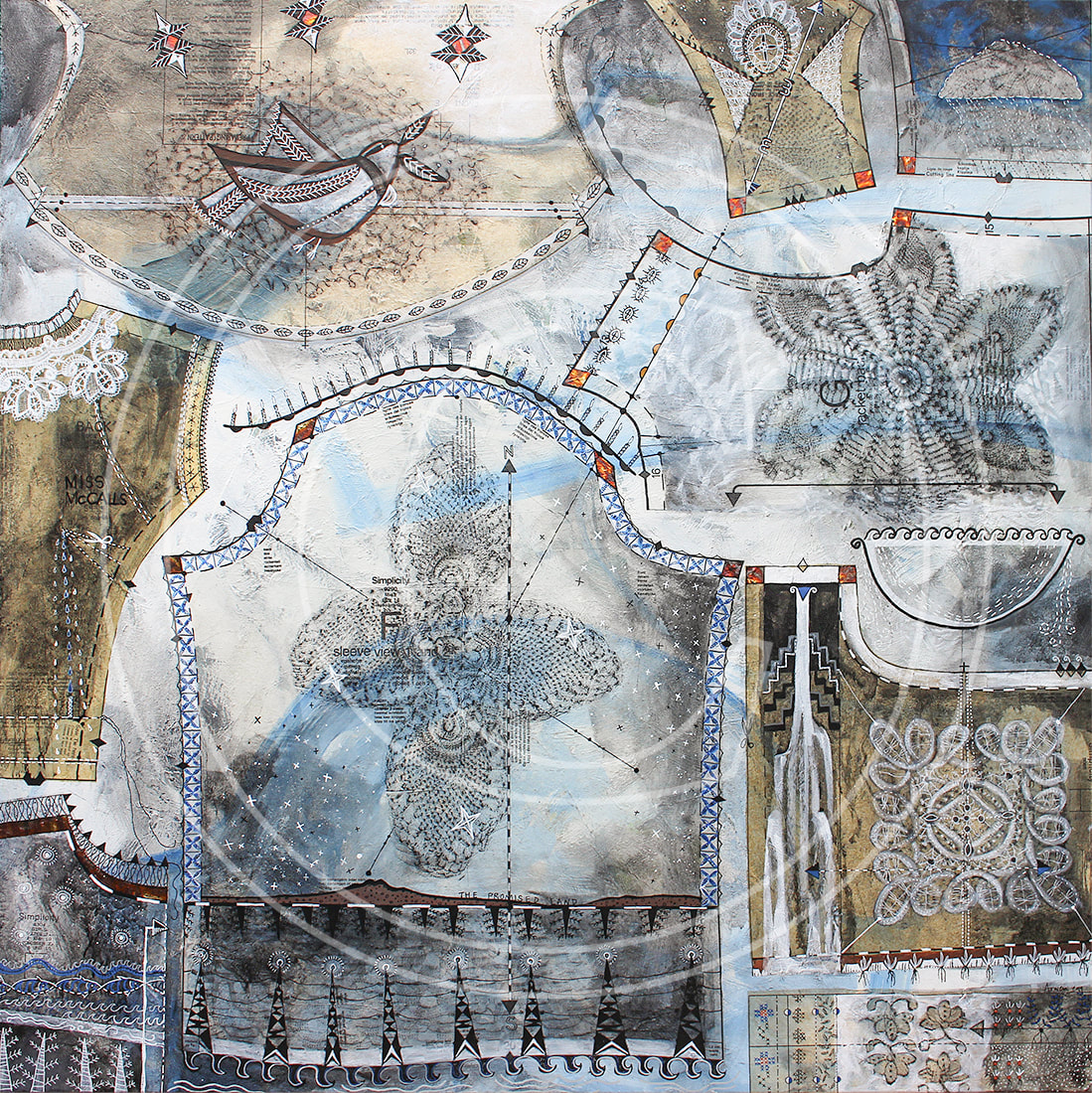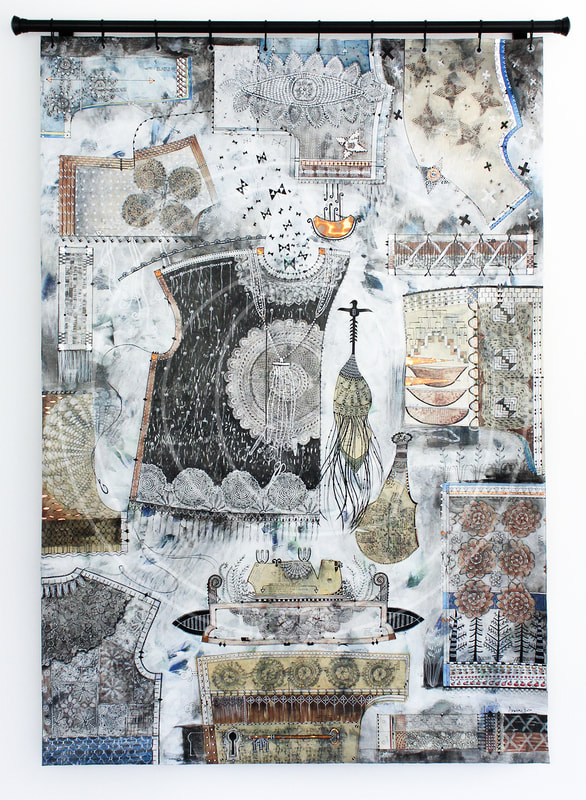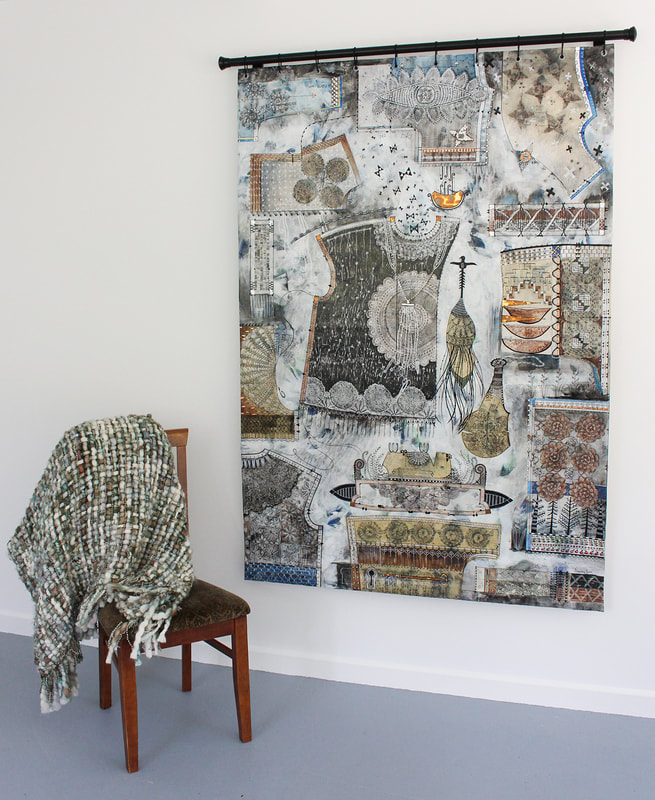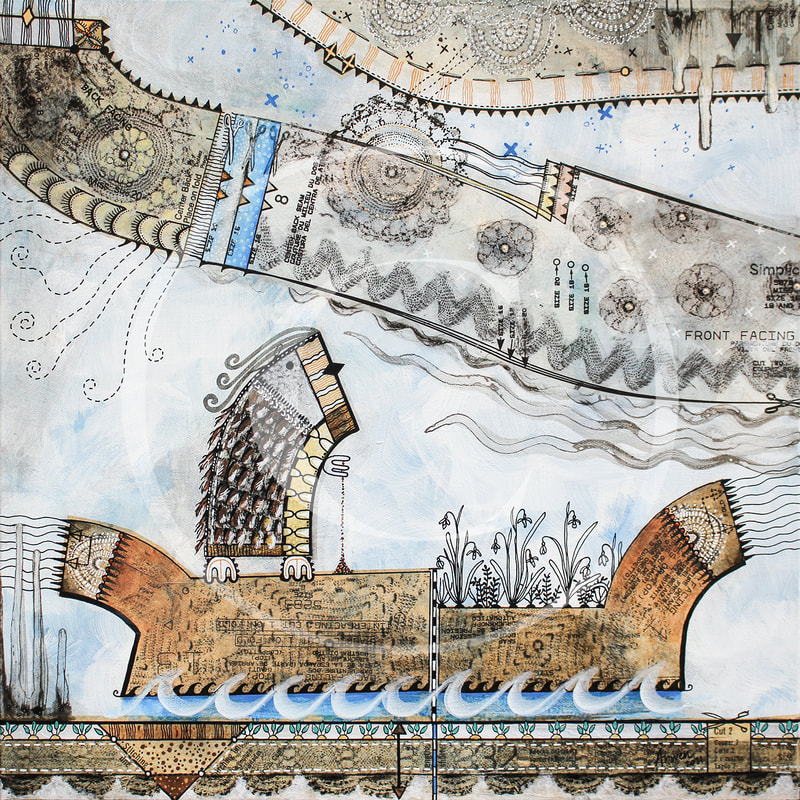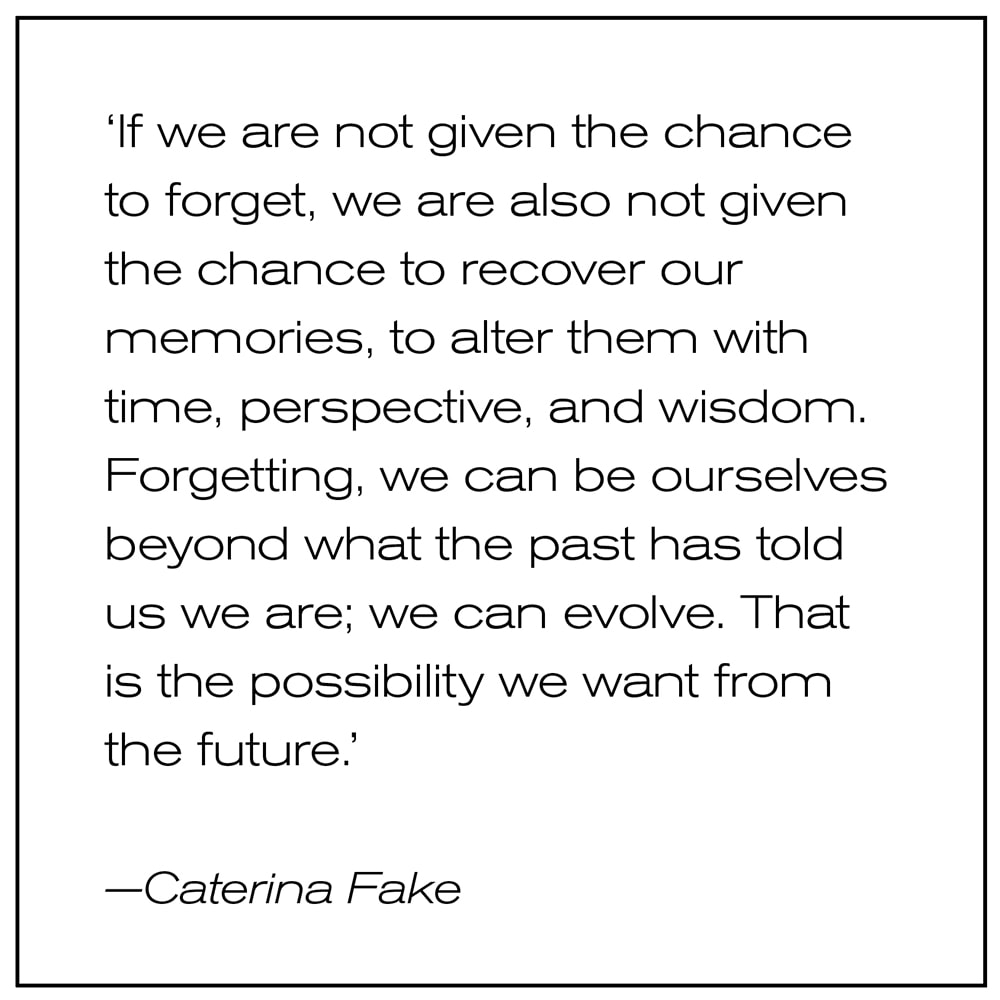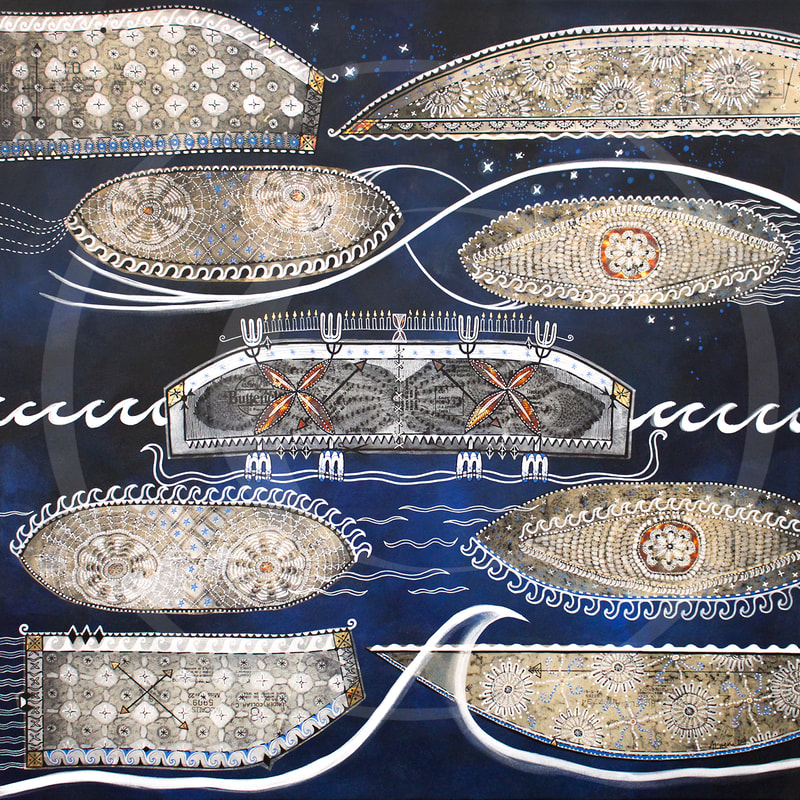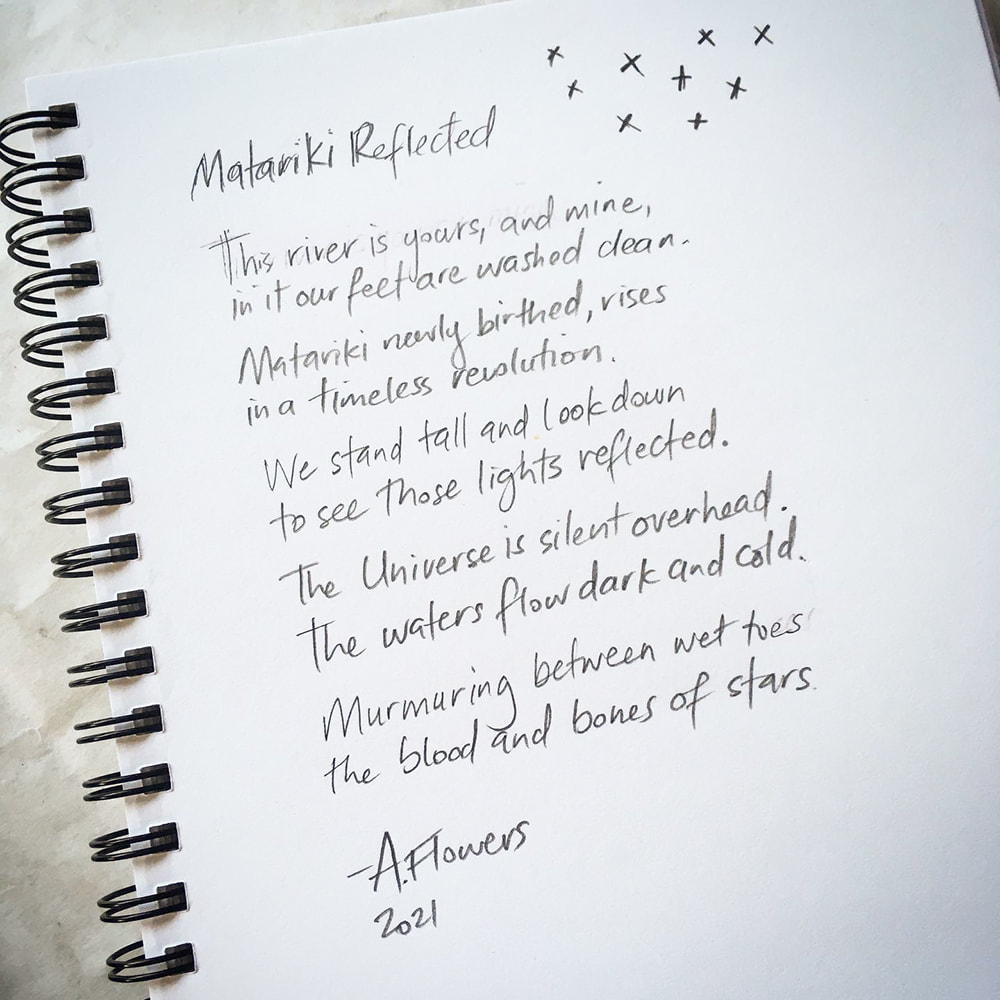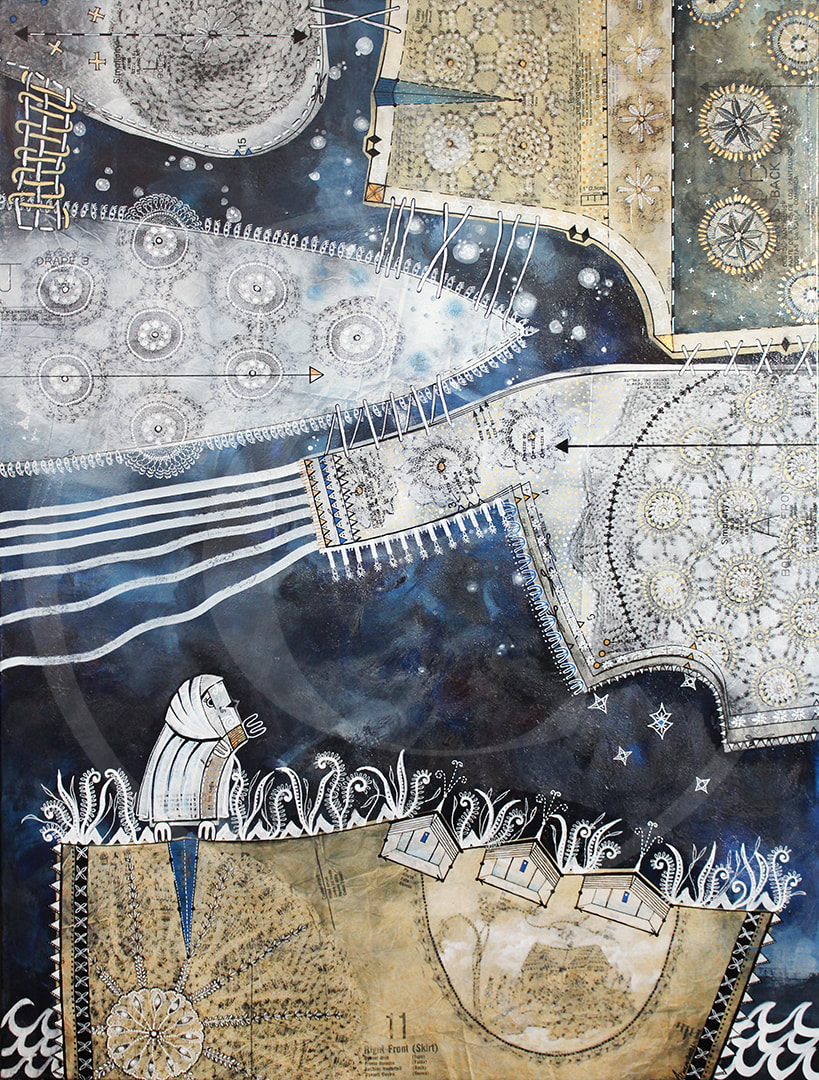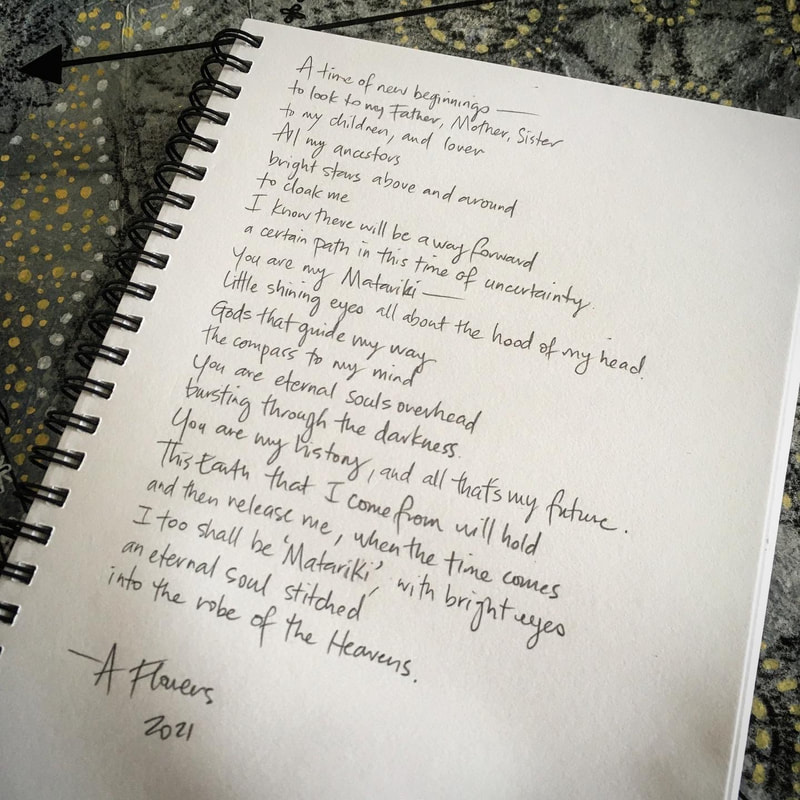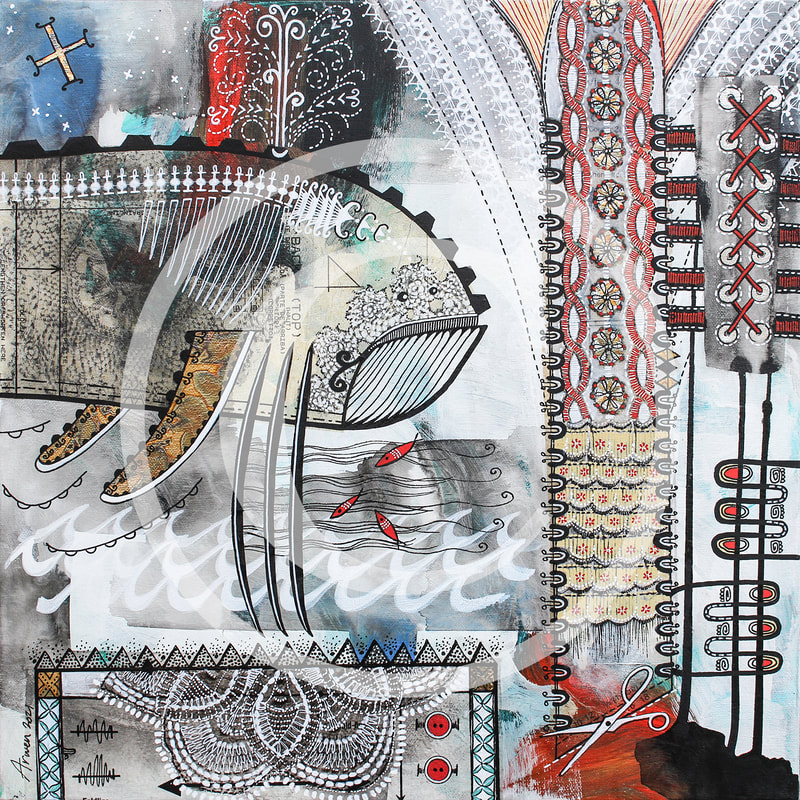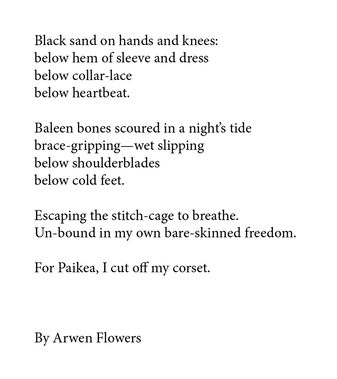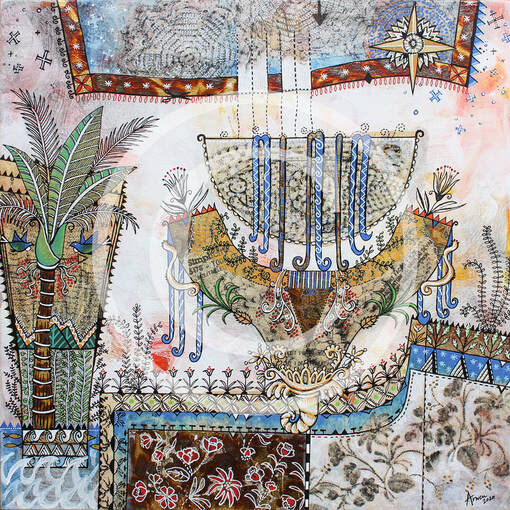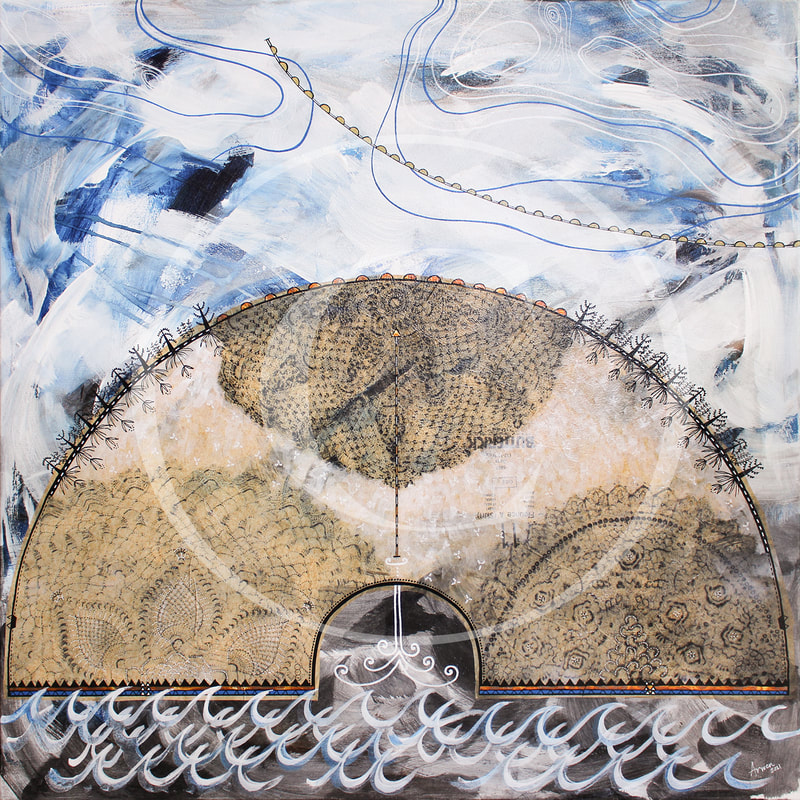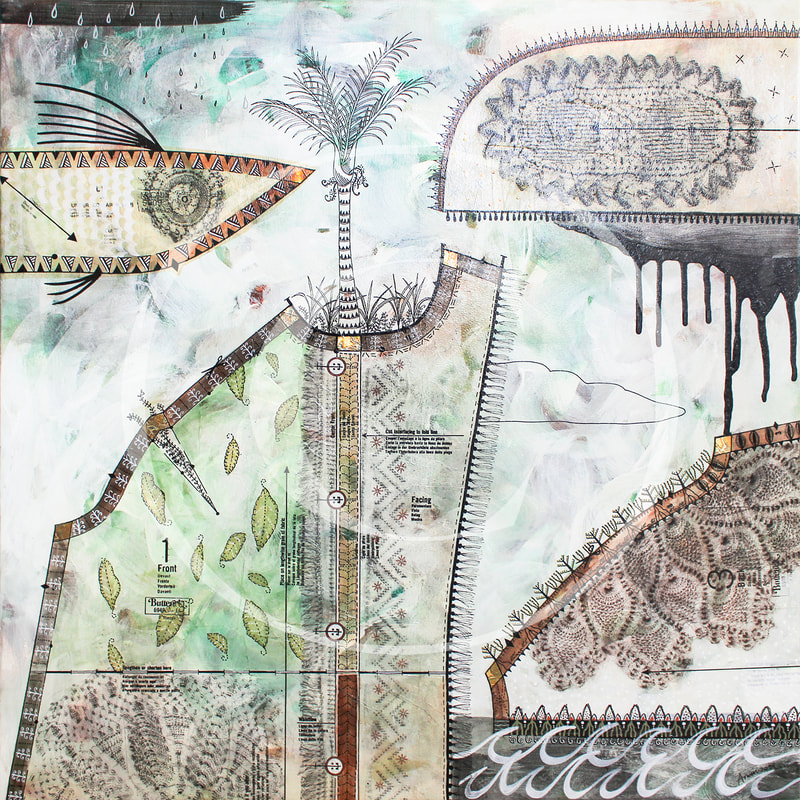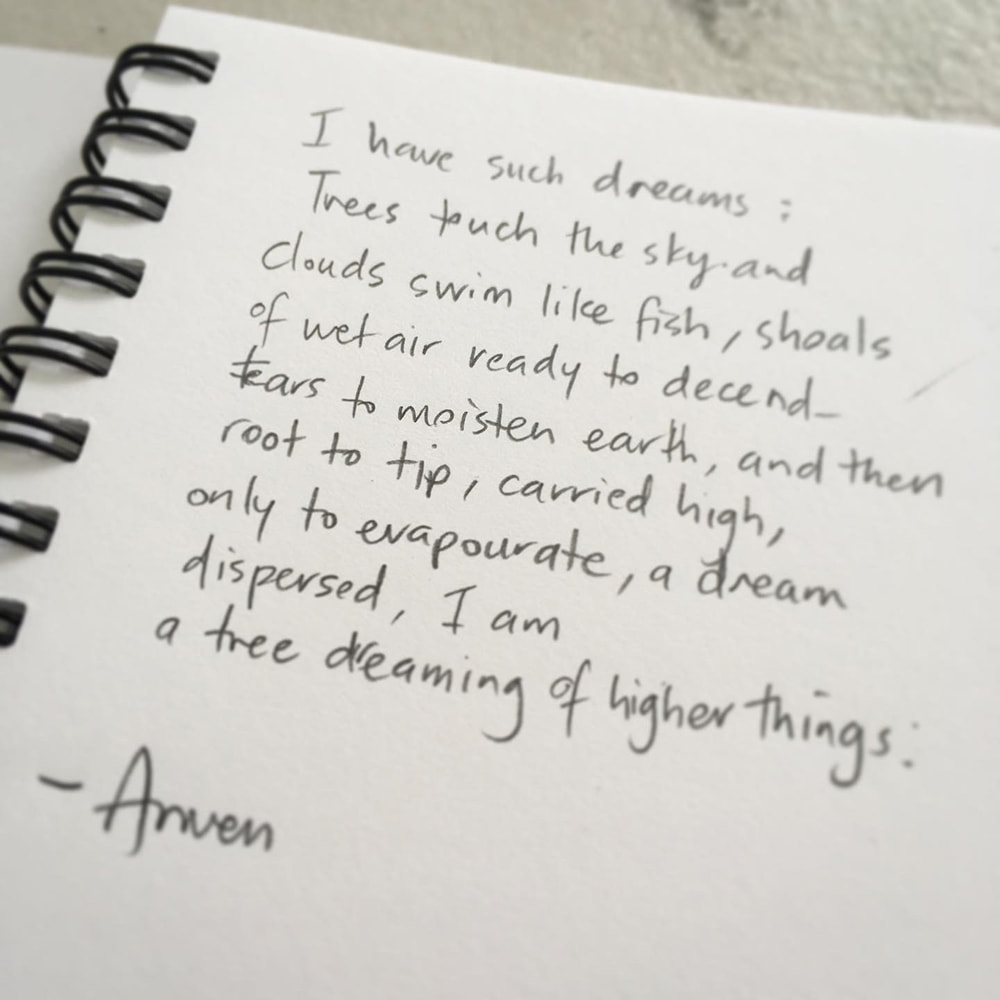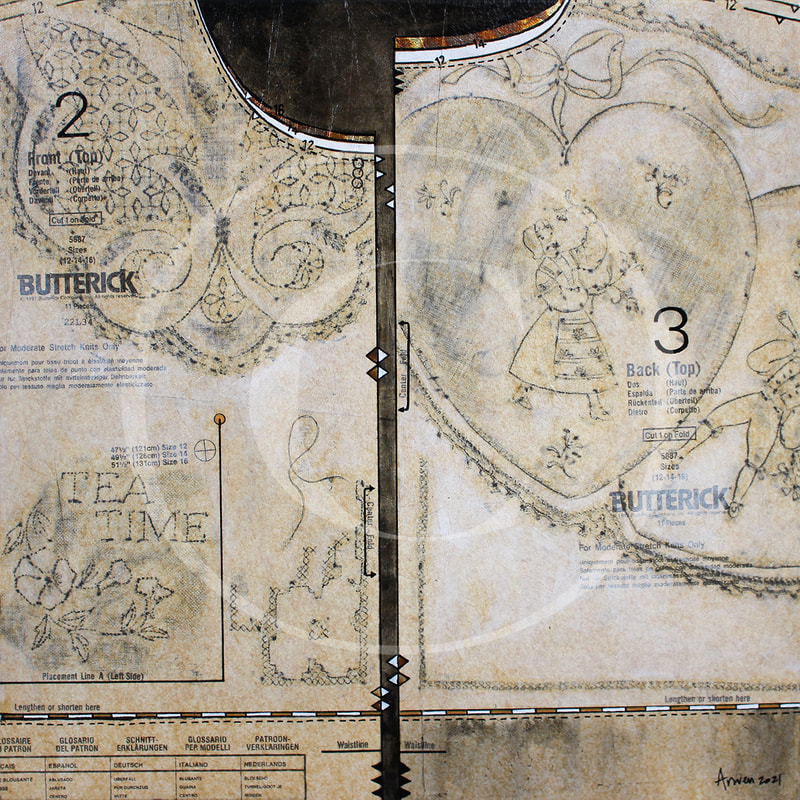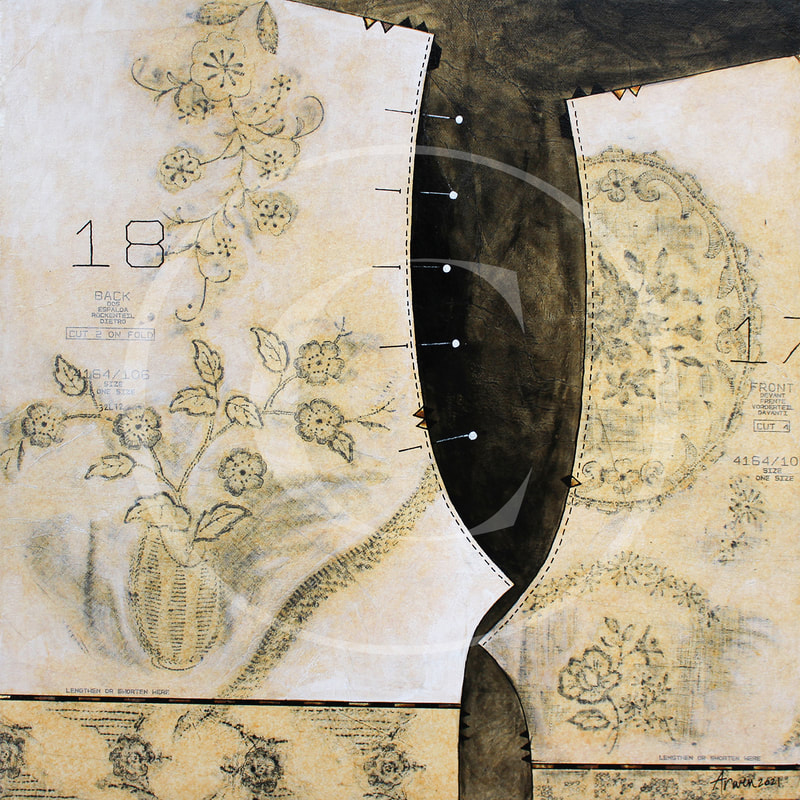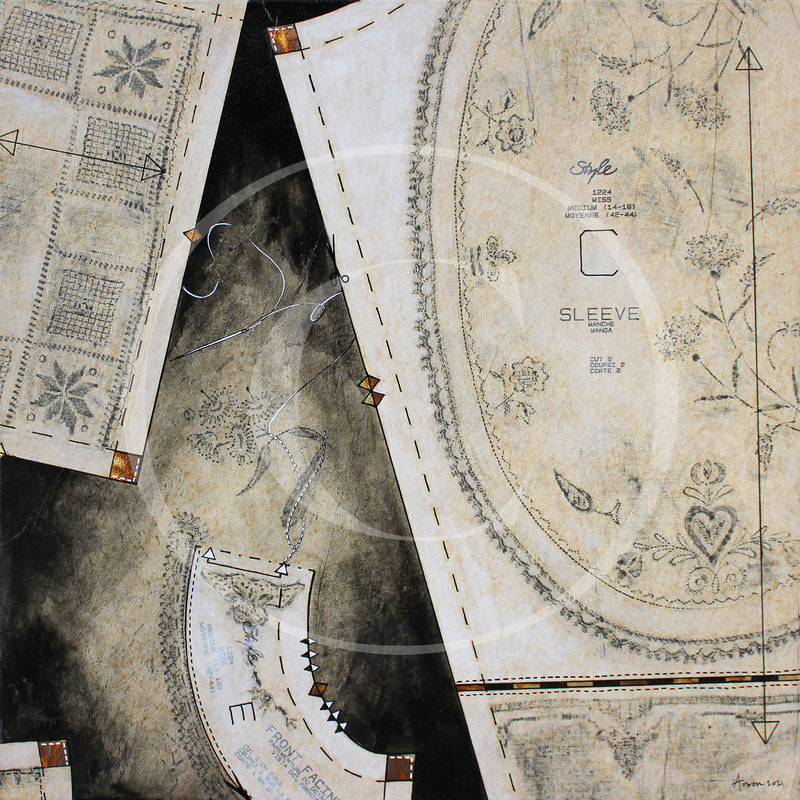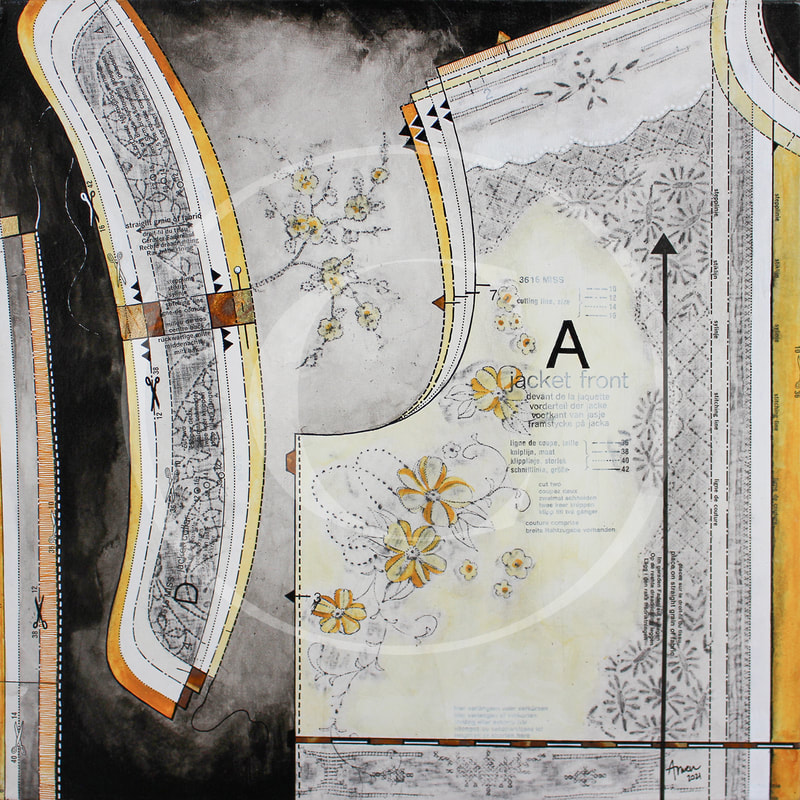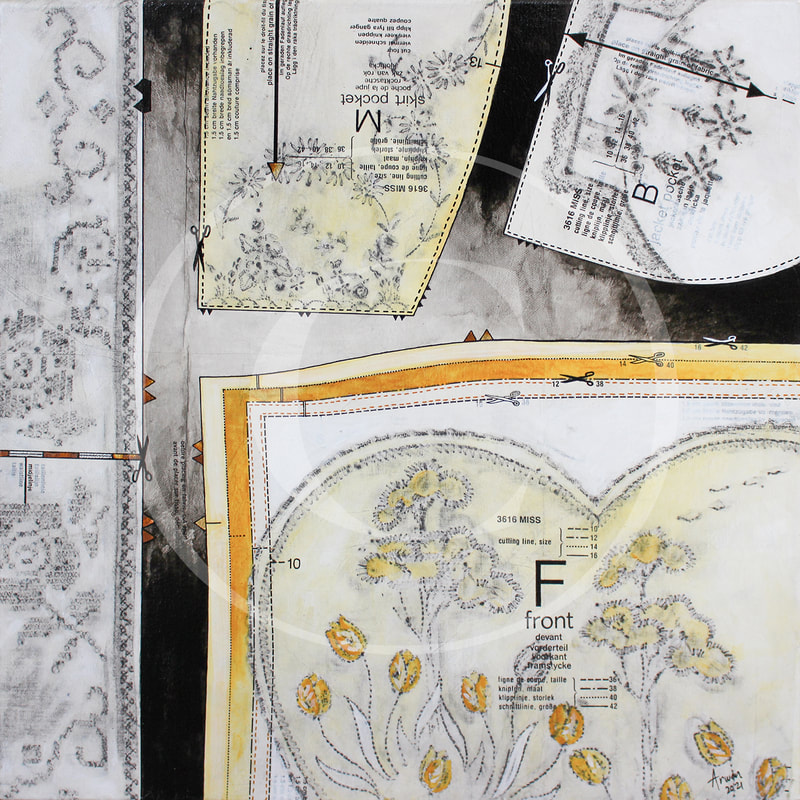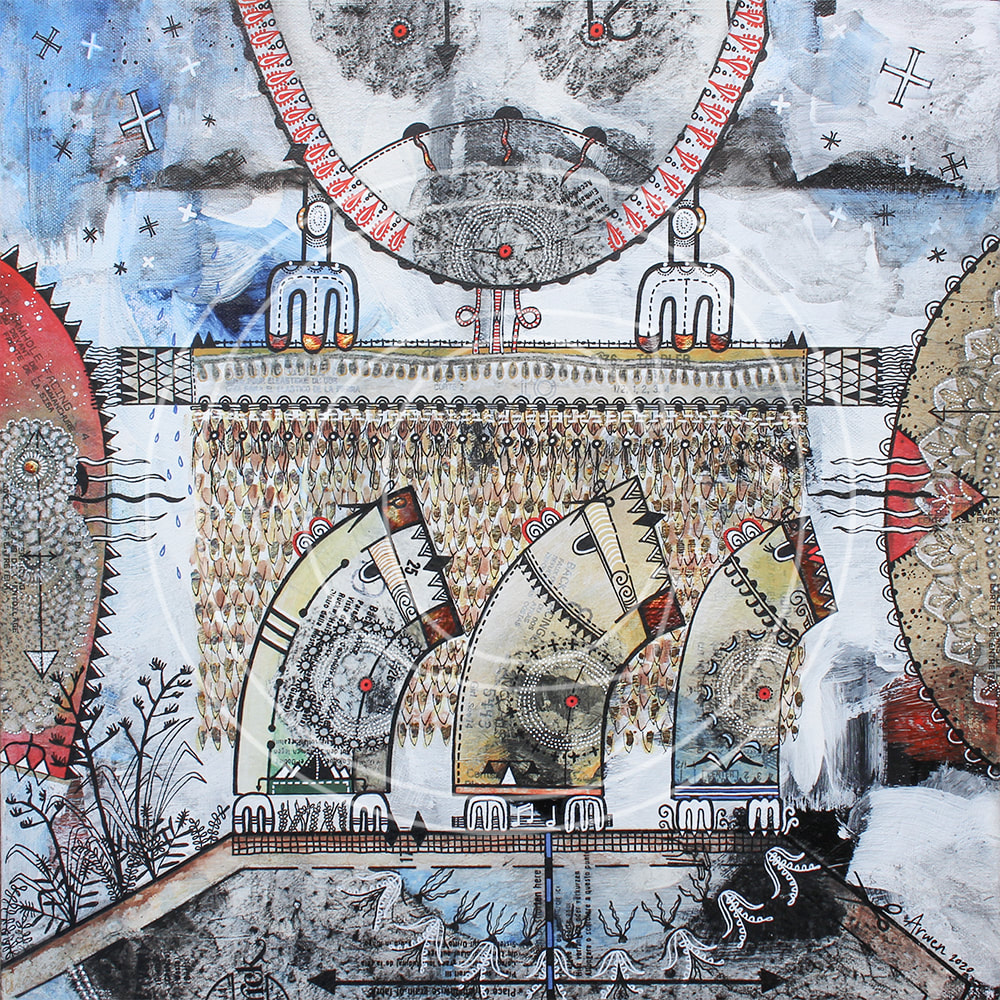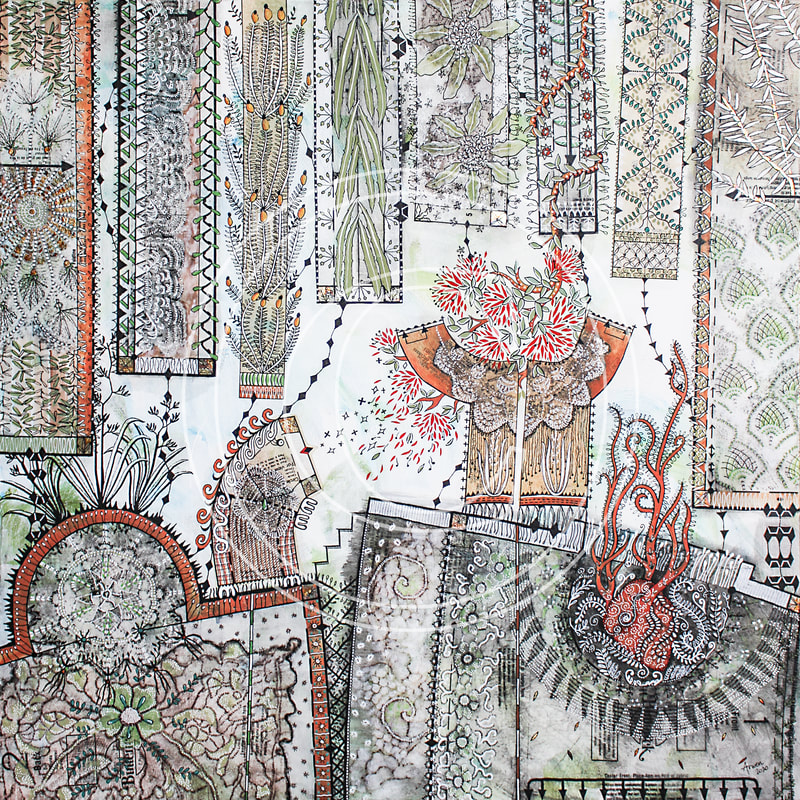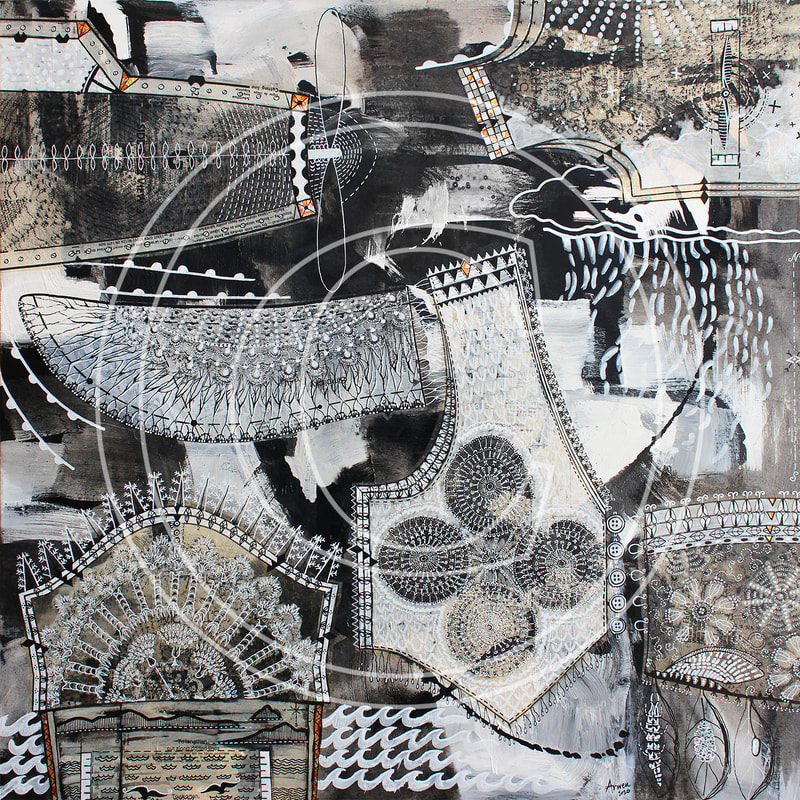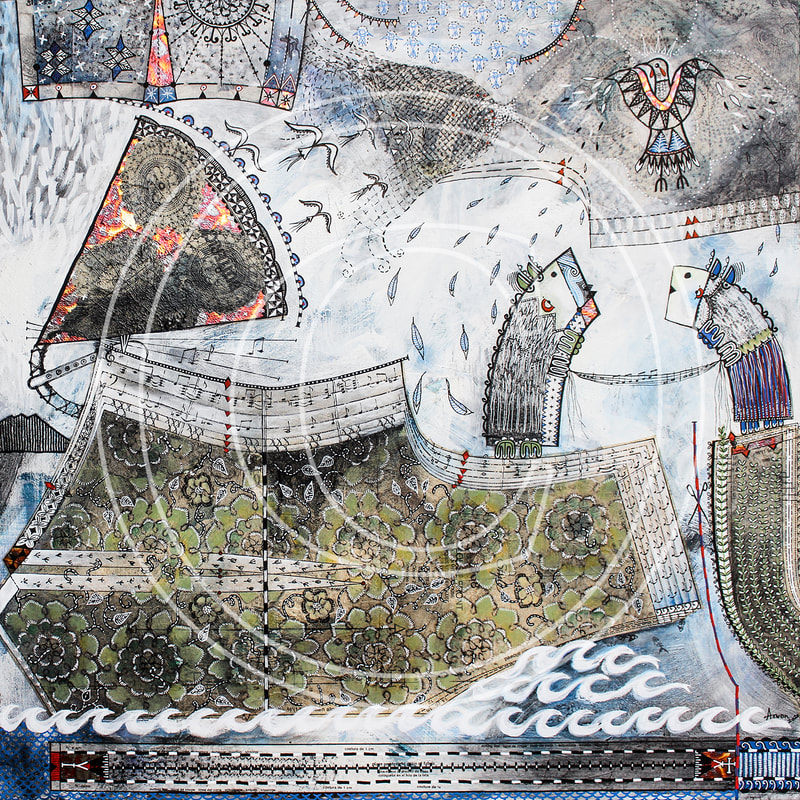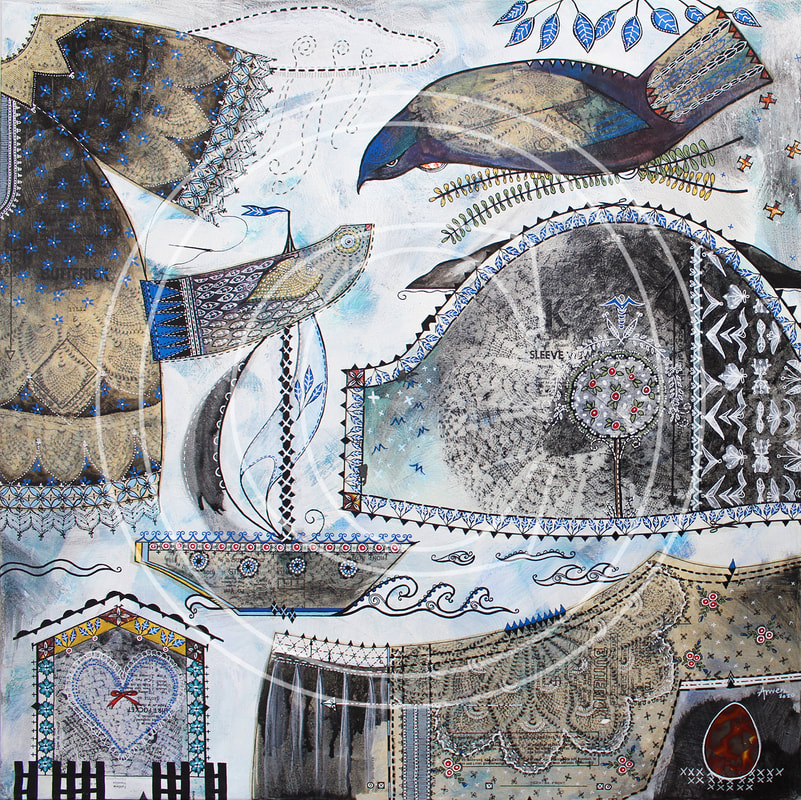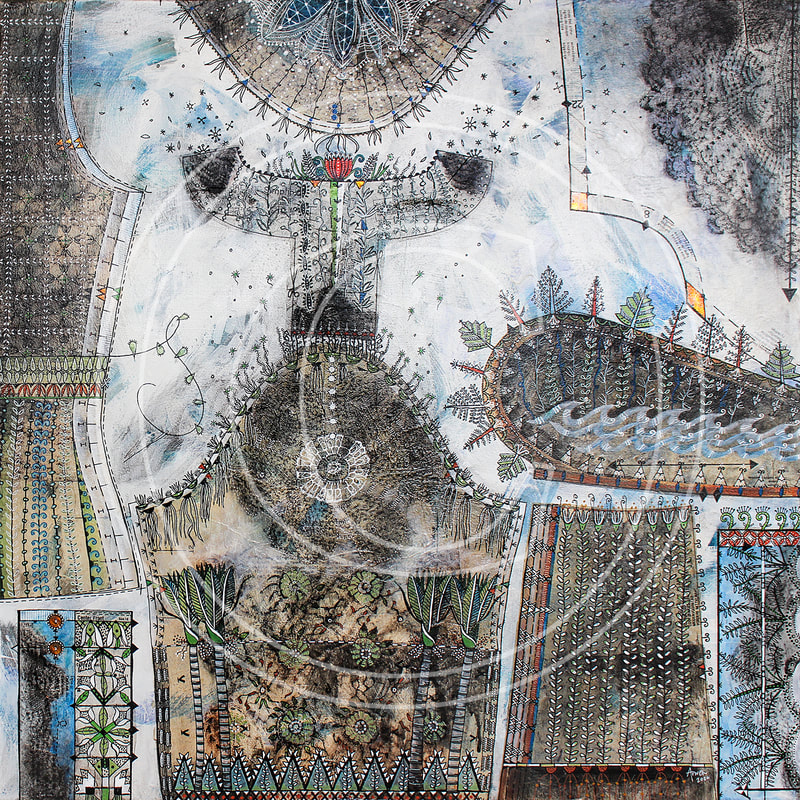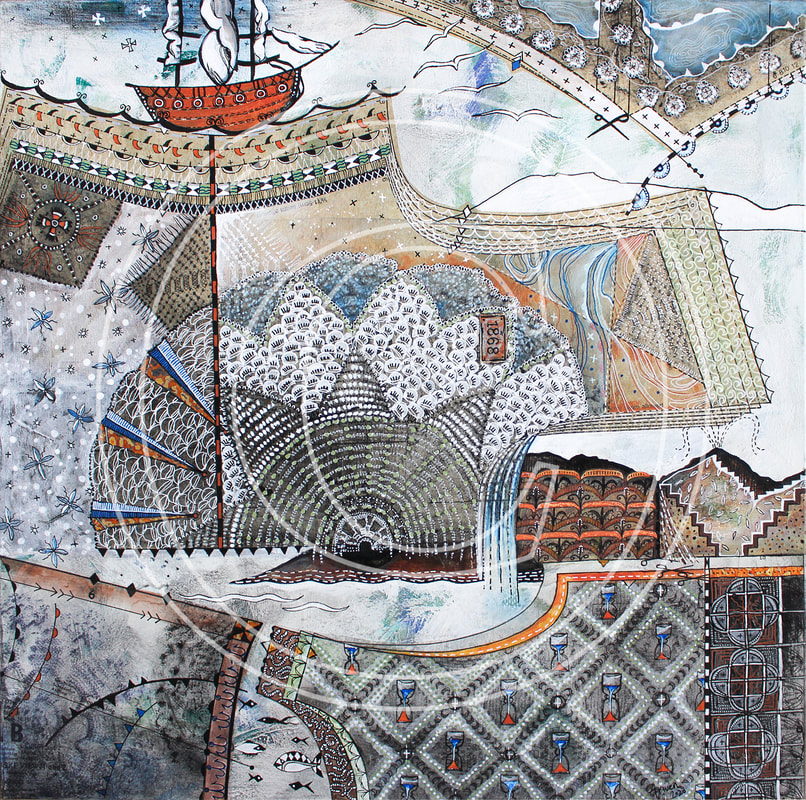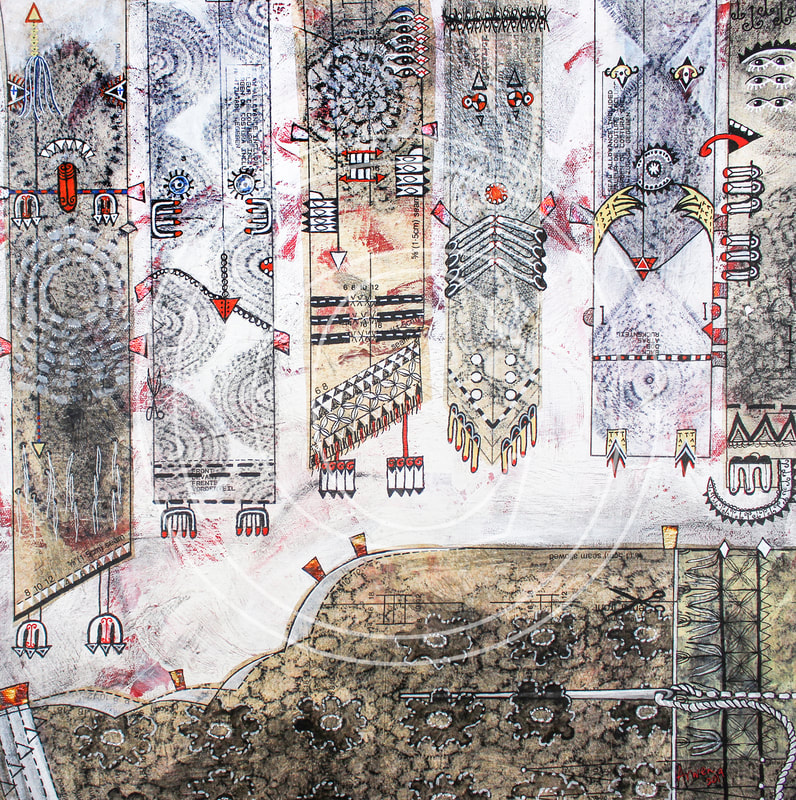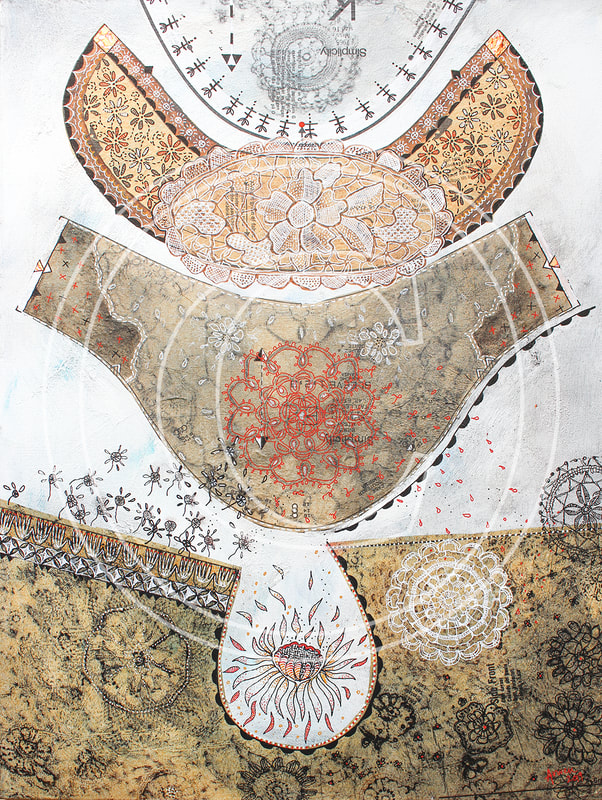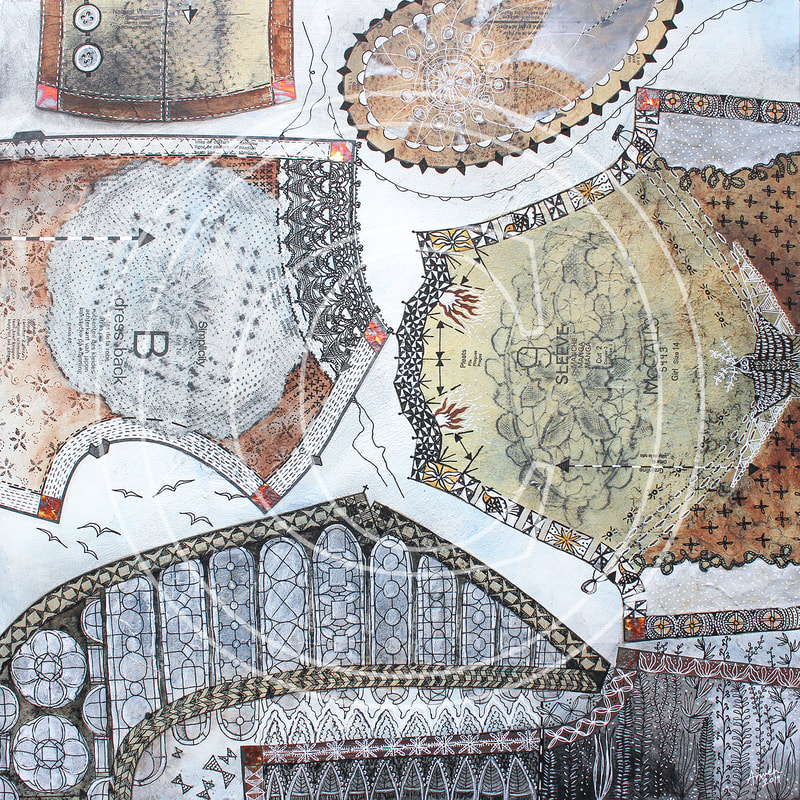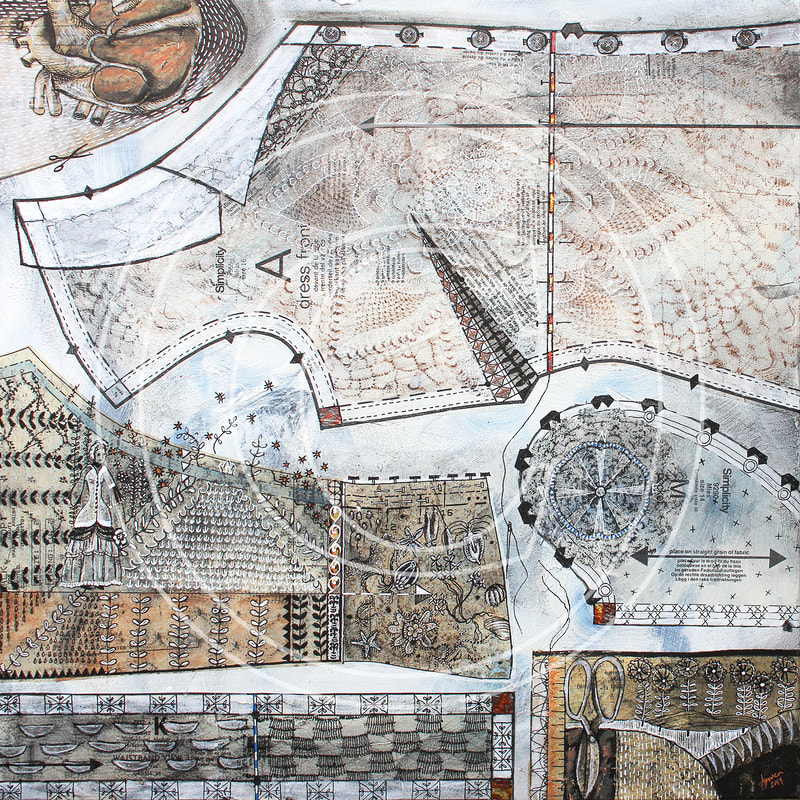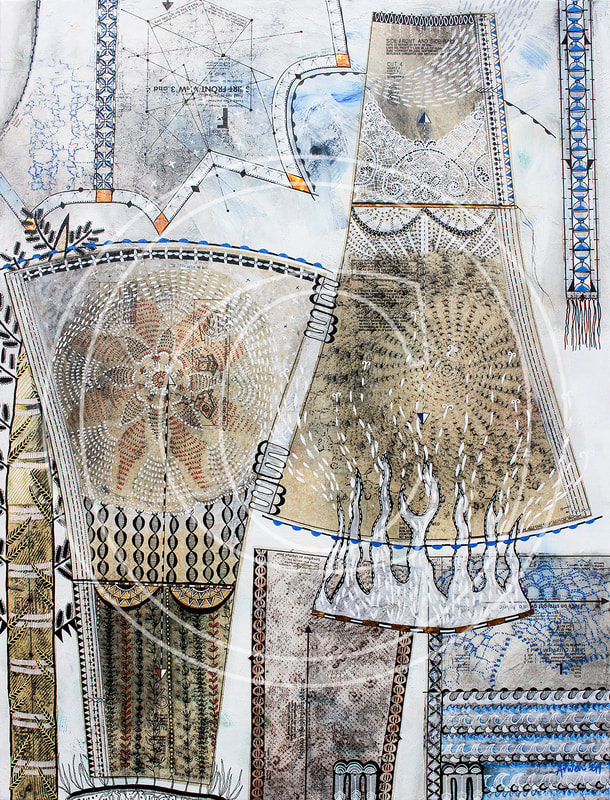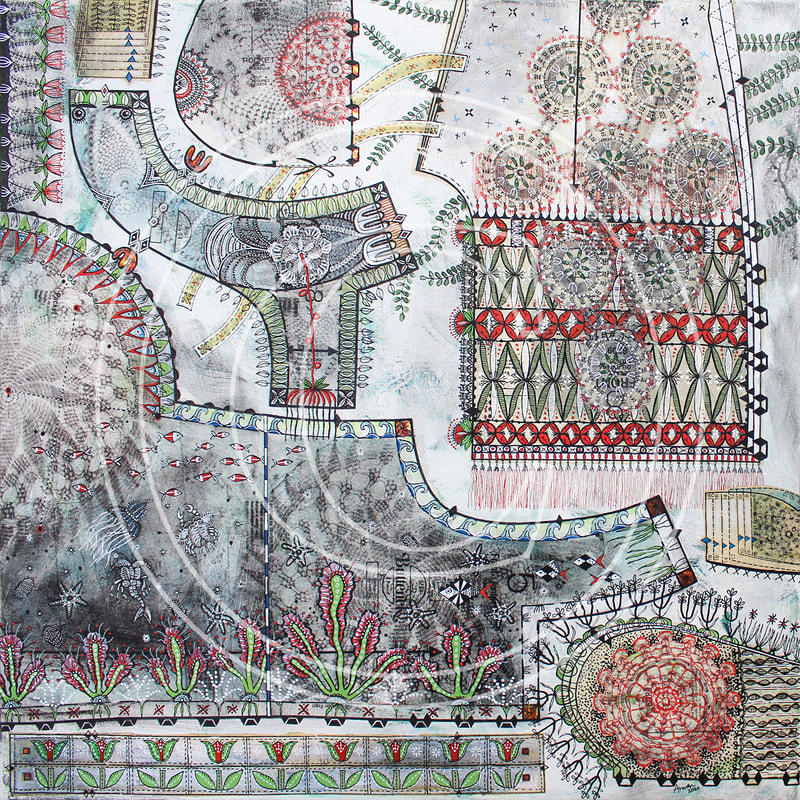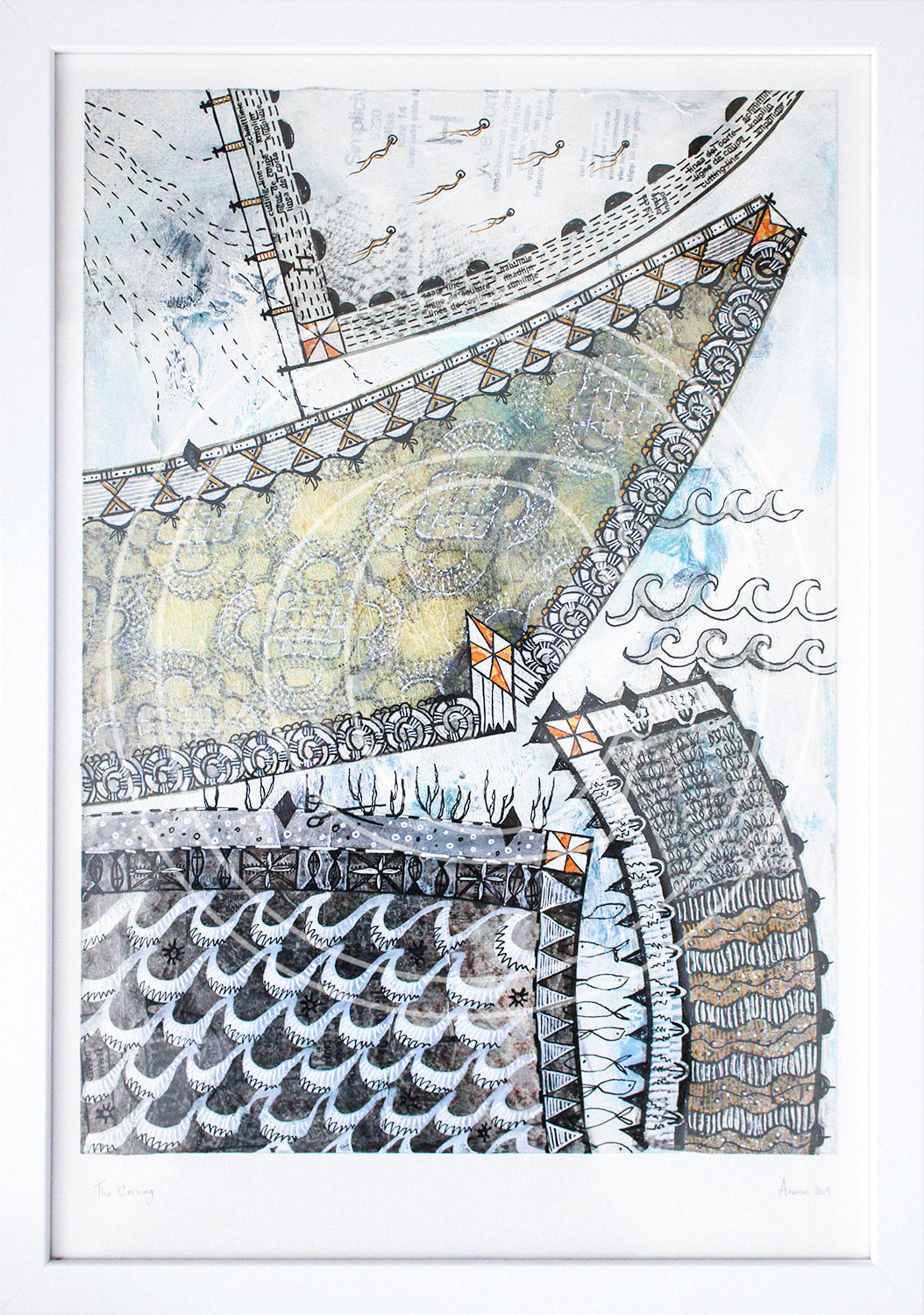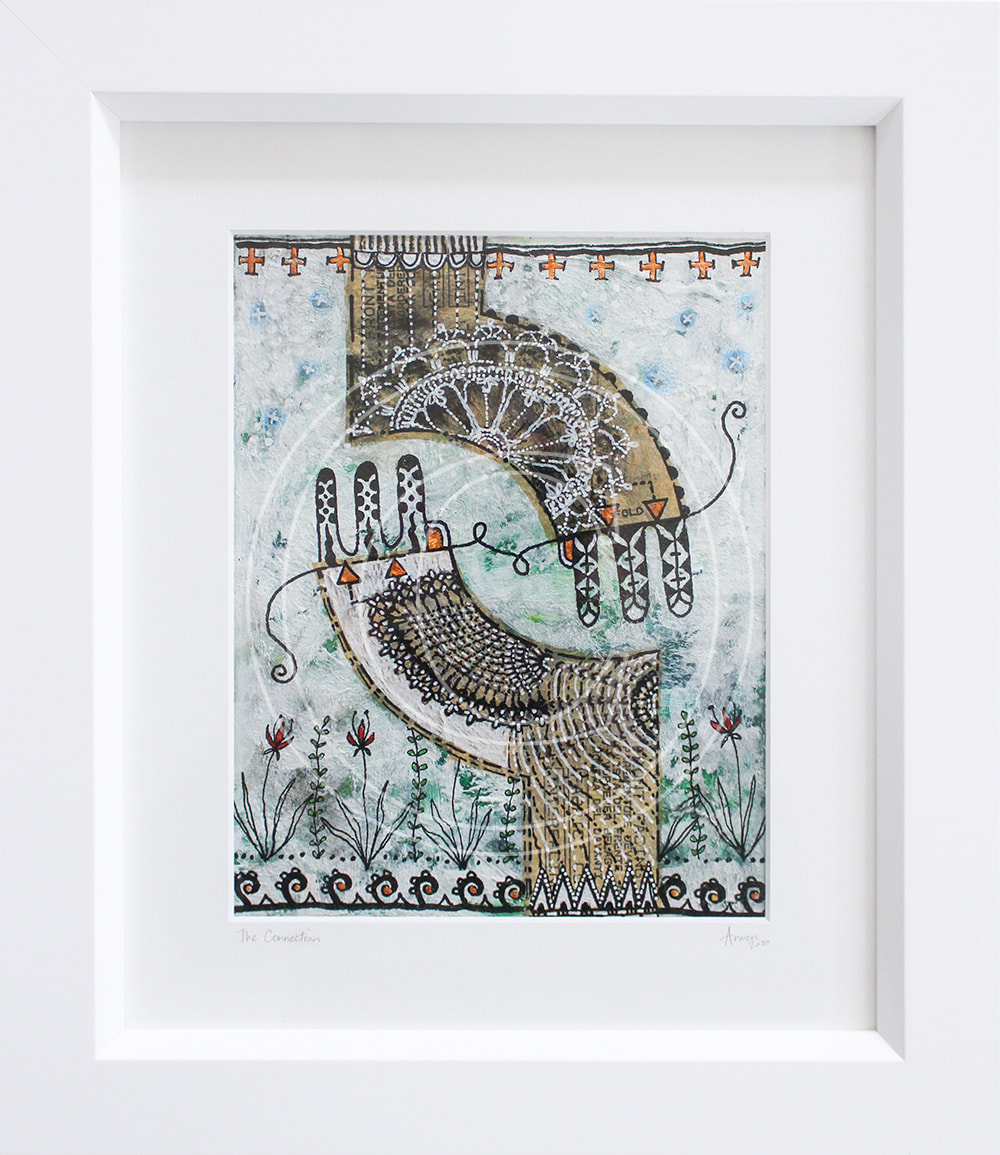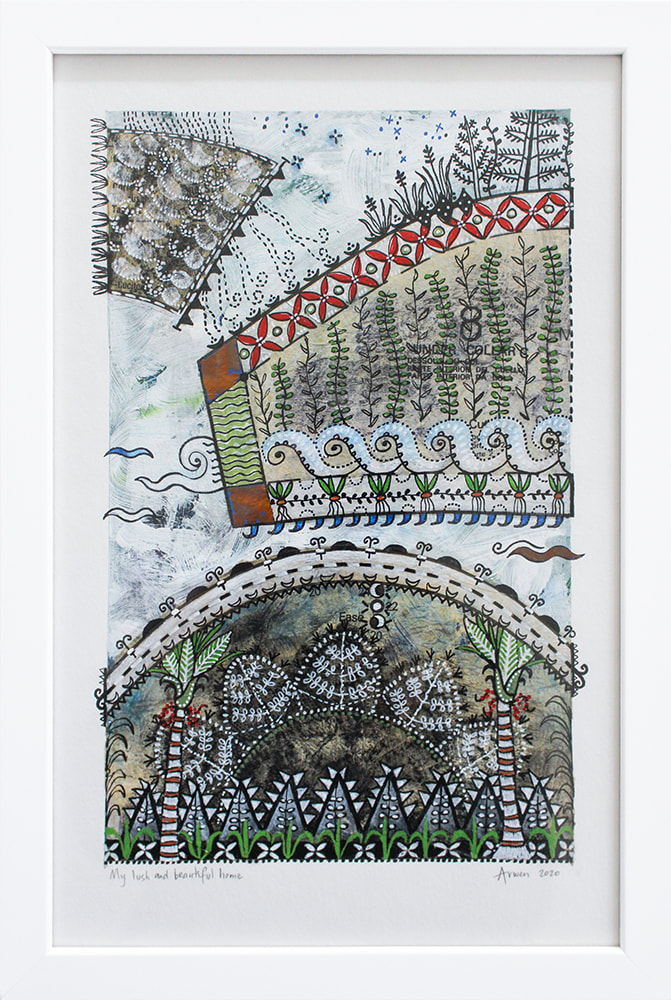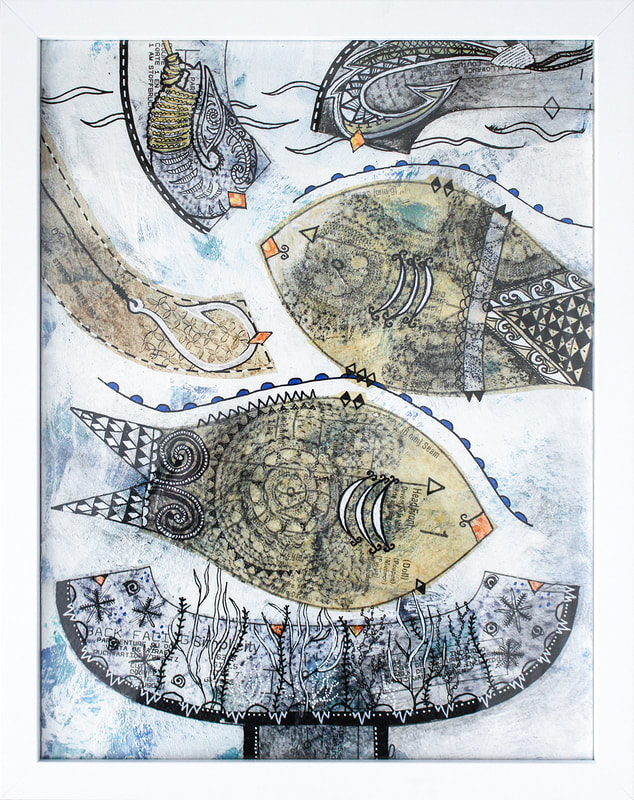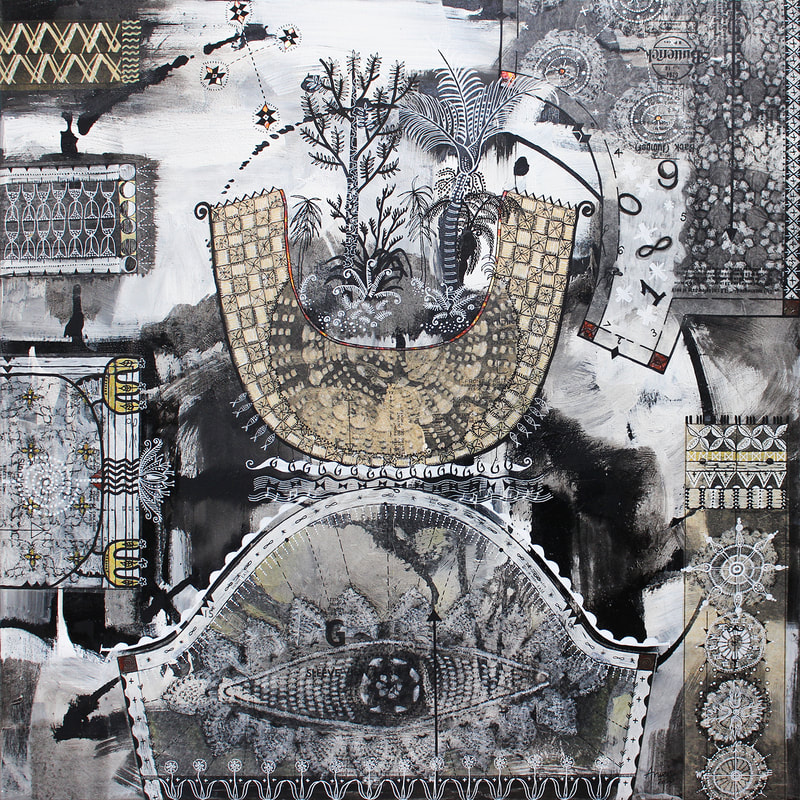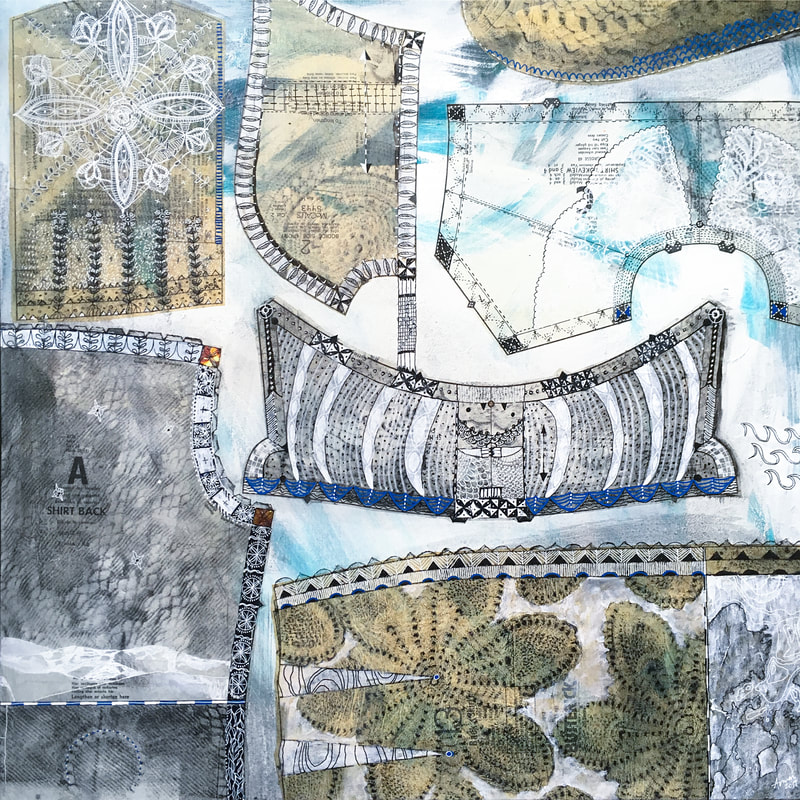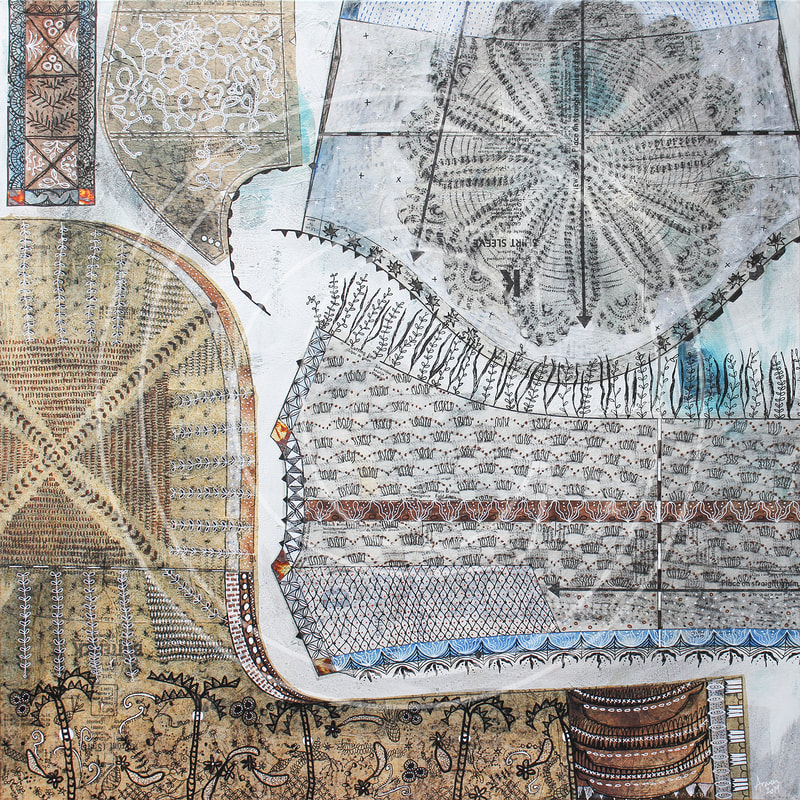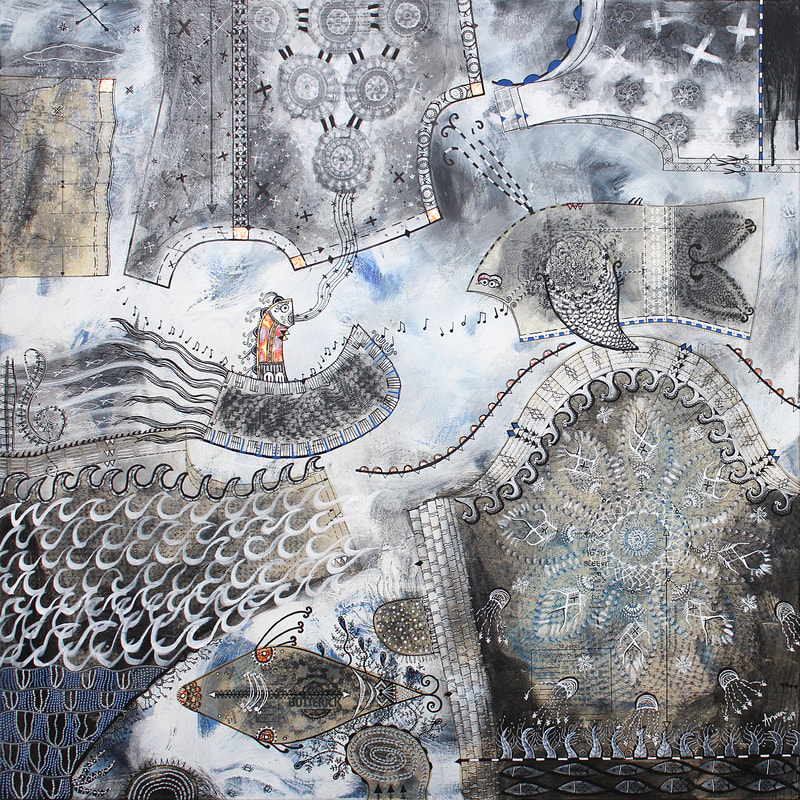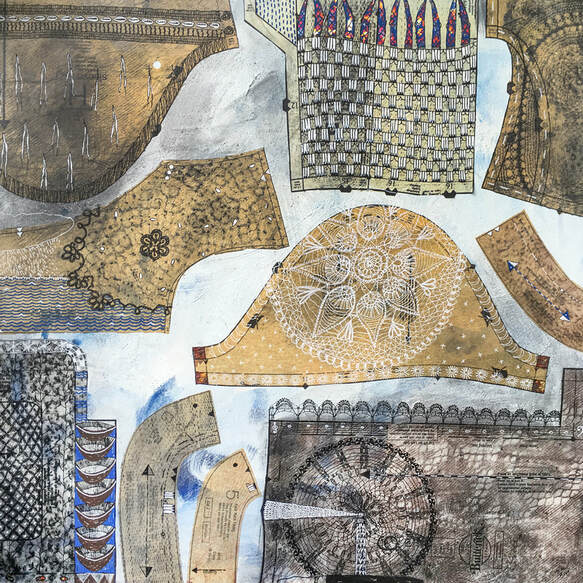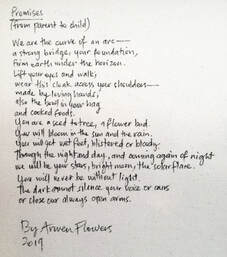Craft & Culture
|
Arwen’s artwork on canvas and paper utilises a unique mix of media—dressmaking patterns, graphite, charcoal, metallic foil, and paint. Through this multi-media approach Arwen references landscape and oceanic forms while exploring intersections, crossovers, and parallels between historical and modern European and Pacific Island cultures, often from a feminine perspective.
‘I love how dressmaking patterns speak about identity, who we are on the outside and inside; the tissue paper is fine and transparent, it’s like a kind of skin. Each shape, like Tapa, can be filled with designs. I use each piece as a space to tell part of a story. Tapa is a hand-made product that contains an imprint, a kind of memory of the women who have produced it. I believe clothing, doilies, embroidered items also carry imprints or ‘memory’ of those women who have made them. I wonder about the thoughts these women had, the conversations, feelings, ideas that they had or expressed while working a needle or beating at paper mulberry fibres. Women have long used the art of decoration to elevate everyday objects and to adorn themselves. Pattern and design are a form of communication across culture, time and place. —Arwen Flowers. |
|
The promised land of Miss McCalls
1000 x 1000 Mixed Media - Paint, dress patterns, graphite, charcoal, gold foil SOLD —————————————————————-- Supreme Winner of The Trusts Greater Auckland Art Awards Judges comments: “The judges believe that Arwen's supreme painting award amalgamates personal and collective iconographies in an unusual experiment that has a narrative reality of exceptional and outstanding merit.” —————————————————————-- Winner of the Inspirational NZ category Judges comments: “A seriously well inspired response to painting tradition, textiles, place, collage and time. Brilliantly executed and realised.” —————————————————————-- View the Finalists Catalogue HERE |
|
The Ancestors
1400 x 1900 Mixed Media - Paint, dress patterns, graphite, charcoal, metallic foil READ POEM HERE |
Themes of memory, time, and healing.
The left side of this piece desks with memory/past and the right with ideas/thought and the future, while the central figure allows the ‘sands of time’ to pass through open fingers. Grey hair for maturity, a ‘boat’ vehicle for travel, and water represents both healing, continual change and a way of travel. The plants are for new growth. Some of the lines indicate connection. The figure wears a cloak of owl/Morepork feathers for protection and wisdom. I’ve used a soft, muted colour palate as the brief was for this to be a contemplative piece.
The left side of this piece desks with memory/past and the right with ideas/thought and the future, while the central figure allows the ‘sands of time’ to pass through open fingers. Grey hair for maturity, a ‘boat’ vehicle for travel, and water represents both healing, continual change and a way of travel. The plants are for new growth. Some of the lines indicate connection. The figure wears a cloak of owl/Morepork feathers for protection and wisdom. I’ve used a soft, muted colour palate as the brief was for this to be a contemplative piece.
Samplers (Click for titles)
460 x 460 each
Mixed Media - Paint, dress patterns, graphite, metallic foil
460 x 460 each
Mixed Media - Paint, dress patterns, graphite, metallic foil
|
Umbilical Cord
460 x 460 Mixed Media - Paint, dress patterns, graphite, charcoal, metallic foil *Commissioned piece This special piece is both a commission and collaboration. I created it in response to a poem written by Nerina Howe, who is also the recipient of the work. Some of the visual references drawn from the poem are — the Umbilical Cord: connection to her three children, sperm/eggs in the Mother's belly, Guardian presence, and Breath of Hope and New Life on each side. The mother's cloak, her Korowai of motherhood is held up behind them. I have used some of the patterns to reference the children's family heritage (Maori, Samoan, Niuean, English, Irish, Scottish). Each child is personalised to information Nerina shared with me, as well as many intuitive elements I have added along the way. ‘...Mokopuna E, Your umbilical cord, The breath of new life.' —Excerpt from ‘Umbilical Cord’, by Nerina Lillian Howe. FULL POEM HERE |
|
Witness — from the earth, this blooming
800 x 800 Mixed Media - Paint, dress patterns, graphite, charcoal, metallic foil WITNESS I choose to lay my heart down here, praying it will rise to grow with hope, climbing to meet the sky, its blood branches, vessels as red as Ratapiki vine blooms, while Kauri, Totara, Tawhai Rauriki, Twiggy Coprosma and Kahikatea stand guard as witnesses. I speak of Kawakawa Pounamu, and take hold of that stone -- carved healing from the earth that holds my ancestors' home, this same earth that will hold my own dark cradle, full of little seeds, each reaching towards the light, towards my spirit moving high among branches slick with rainfall, rich with new leaves. — A. Flowers |
|
Lace Wing 760 x 760 Mixed Media - Paint, dress patterns, graphite, charcoal, metallic foil Inspired by the flight of Amelia Earhart across the Pacific, this peice juxtaposes the evolution of a woman's psyche as she becomes aware of the desire to be an explorer against the lifecycle of the Lacewing, an introduced species of insect beneficial to the environment. Lacewings go through a complete metamorphosis, including egg, larva, pupa, and adult. Their larvae are commonly called Aphid lions. LACEWING I would like to be introduced: a new kind of creature-- explorer, but no conqueror. Feed me on honeydew, nectar watch my metamorphosis from Lioness to Lacewing. I was Earth-bound, but like Amelia, I want to be first-- to make my own wings and fly high across the Pacific. — A. Flowers |
|
Last Bird Call — The Archivers
760 x 760 Mixed Media - Paint, dress patterns, graphite, charcoal, metallic foil I have been making work about our relationship with the environment for a few years now, particularly looking at the practice of collecting in its various forms. This new piece was initially inspired by Chris Moore’s sculpture, Bird Songs and a recording made in 1949 by Henare Hāmana, who mimics the different calls of the extinct huia bird. This painting tells a story of two guardians who archive the notes of extinct bird call as many fly through Heavenly nets bound for their place in history. It features landmasses - Gondwana land splitting from New Zealand and a timeline to reference the millions of years birds evolved on our land, prolific and spectacular, until human occupation. |
|
The Bluebird of Happiness
760 x 760 Mixed Media - Paint, dress patterns, graphite, charcoal, metallic foil Won 'People's Choice Award', Kumeu Art Awards 2020. This finished piece was inspired by a chapter in Rosemary McLeod’s book ‘Thrift to Fantasy’ (about textile crafts of the 1930s-1950s). She speaks about a popular idea that may date back to a 1909 play called ‘The Bluebird of Happiness’, where ‘two children search the world for happiness, only to find it in their own back yard.’ In these times of isolation, I’d like to think it’s possible for happiness to be found right where you are. Rosemary writes that the presence of the decorative bluebird in domestic crafts was used as a kind of talisman for an idyllic home-life. I’ve used a free-flying, Tui-like bluebird as an icon in this work juxtaposed against a tethered bluebird - stitched to the woman’s dress. There is a ship: boats have long been used for travel and for those living in New Zealand the only means of arriving and leaving before aeroplane flights were available. I relate this to how limited or no travel options are affecting us all. I have felt the sadness of separation, homesickness and dream about the joy of arrival back to familiar ‘shores’. The egg represents many ideas: new life and ways of being, containment, transition. There is a home with sewn heart and another panel with tree bearing fruit surrounded by a wreath, inspired by embroidery transfer motifs. |
|
Sailing the Matoaka in 1868
610 x 610 Mixed Media - Paint, dress patterns, graphite, charcoal, metallic foil The Matoaka (also known as Mataoka) was a 1092-ton wooden New Brunswick full-rigged ship built in 1853 for Willis, Gunn, & Co. Between 1859 and 1869 she made eight voyages to New Zealand. Her fastest run from Bristol to Lyttelton, New Zealand was 82 days in 1862. On 13 May 1869 she left Lyttelton for London under Captain Alfred Stevens with 45 passengers and 32 crew but was never seen again. SAILING THE 'MATOAKA' In the leap year of 1868 Transit begins, dividing Ireland to Island and so Beginning with no end in sight A year of the shortest day and This longest night—a listless night Chill, when the sand from home Shores have blown clean away I look overboard and wish I was No piece of lagan trailing One globe-side to the other Borne along by a buoyant bridge The line of my heart taught The line of my mind tracing Paths of leaving, ending With one last jump To shore and who knows Will this become another Home, to serve as home? — A. Flowers |
|
We made the Gods dresses of Tapa and Lace
455 x 455 Mixed Media - Paint, dress patterns, graphite, charcoal, metallic foil This piece tells a fantastical mythological tale about a group of women (European and South Pacific both), who while sewing together on a hill, were approached by a group of agitated Gods. The women used sewing magic to make dresses, convincing the Gods to wear them. For a day the Gods became benevolent Goddesses cavorting around with falsetto voices, full of laughter. |
|
We give flowers
400 x 605 Mixed Media - Paint, dress patterns, graphite, charcoal, metallic foil I think that women of the South Pacific and also those European women who have settled here no doubt formed relationships with one another (and still do) through a shared love of ‘making’ — using creative, decorative language common to both; nature-based symbolism features often. Here I have focused on the floral. Women give and receive bouquets to honour love, friendship, thankfulness, birth and death. They decorate the home, furnishings and ceremonial spaces. Women decorate themselves and have been referred to as 'flowers'. The virgin blooms... |
|
Both beautiful
610 x 610 Mixed Media - Paint, dress patterns, graphite, charcoal, metallic foil The piece explores the concept of two women from different backgrounds, in another time, meeting for the first time, and how as they spend time together their unique culture and life experiences are shared. I wish that social and cultural evolution could always happen with an attitude of love and grace. |
|
Solanum—The story of Jeanne Baret
610 x 610 Mixed Media - Paint, dress patterns, graphite, charcoal, metallic foil —————————————————————-- Jeanne Baret (1740 – 1807) was a member of Louis Antoine de Bougainville's expedition on the ships La Boudeuse and Étoile in 1766–1769. Baret is recognized as the first woman to have completed a voyage of circumnavigation of the globe. Jeanne Baret joined the expedition disguised as a man, calling herself Jean Baret. She enlisted as valet and assistant to the expedition's naturalist, Philibert Commerçon (anglicized as Commerson), shortly before Bougainville's ships sailed from France. According to Bougainville's account, Baret was herself an expert botanist. |
|
From one island to another
For one woman to another 765 x 1020 Mixed Media - Paint, dress patterns, graphite, charcoal, metallic foil —————————————————————-- Created in response to a poem by Divyaa Kumar as part of a collaborative exhibition at Comet Project Space, Ponsonby, Auckland. READ POEM HERE |
|
My Pohutukawa - I am born of land & sea
760 x 760 Mixed Media - Paint, dress patterns, graphite, charcoal, metallic foil SOLD I am from the land and the sea. When I was newly born my mother took the afterbirth and buried it under our favourite Pohutukawa, then washed me in a rock pool made warm from the low-tide sun. I still remember the shadows and shapes of seaweed floating across my eyes. The Pohutukawa flowers always bloom on my birthday when there is seafood, ripe under the waves. I never go hungry.’ — A. Flowers ..... If you look closely you can see the baby, birthing apron or cloak, the buried afterbirth panel, rock pool of fantasy Pohutukawa-inspired sea plants and creatures and the belly of the Mother. |
|
The Crossing
360 x 515 framed size with a 15mm profile Mixed Media on Hahnemuhle Britannia Watercolour 300sm paper - Paint, dress patterns, graphite, charcoal, metallic foil, framed SOLD |
The Connection
320 x 370 framed size with a 20mm profile Mixed Media on Hahnemuhle Britannia Watercolour 300sm paper - Paint, dress patterns, graphite, charcoal, metallic foil SOLD |
|
My lush and beautiful home
265 x 395 framed size with a 15mm profile Mixed Media on Hahnemuhle Britannia Watercolour 300sm paper - Paint, dress patterns, graphite, charcoal, metallic foil SOLD |
Aloha, Aranui and Adelpha go fishing
345 x 435 framed size with a 35mm profile Mixed Media on Hahnemuhle Britannia Watercolour 300sm paper - Paint, dress patterns, graphite, charcoal, metallic foil, framed SOLD |
|
Birthing a new civilization
760 x 760 Mixed Media - Paint, dress patterns, graphite, charcoal, metallic foil SOLD While creating this artwork I found a dressmaking pattern piece shaped like a cradle or crescent. My imagination was captured by the idea of a ‘cradle of civilization’ — a location where civilization is understood to have emerged. A ‘fertile crescent’ is home to some of the earliest human civilizations, an area that is the birthplace of technology — innovations like writing, the wheel, agriculture, and the use of irrigation. I drew a mythological woman, mother of all, birthing new worlds when old ones wither and die. She is featured in the ‘Agricultural panel (mid-left side). |
|
The vessel of my mother
760 x 760 Mixed Media - Paint, dress patterns, graphite, charcoal,metallic foil SOLD It was Mother’s Day when I was working on their piece. I wanted to think of motherhood, the aspects of carrying your children, keeping them safe, love and protection. This painting has become one that honours my mum and her connection to my sister and me. |
|
Roots in the soil
760 x 760 Mixed Media - Paint, dress patterns, graphite, charcoal, metallic foil SOLD This piece was inspired by the idea of a Mother and children arriving in a new place and planting out gardens. Probably with seeds and plants brought on the journey. There is joy in discovering what is already edible, medicinal or useful in other ways. |
|
Whānui and Tangaroa's navigation song (Lyra & the Whale)
1000 x 1000 Mixed Media - Paint, dress patterns, graphite, charcoal, metallic foil SOLD It appears that Whānui is the Maori name for bright star Vega - Vega is part of the 6-star constellation of Lyra. Tangaroa, a Maori Sea God, is sometimes represented as a whale. Instead of his potential antagonism towards the figure who’s lost at sea, both Tangaroa and Whānui sing a song describing directions to find home. Forgive me that this is my own made-up mythology. It comes from a place of dreams and wishes. If I were lost at sea, this is what I’d want to happen. |
|
Promises
760 x 760 Mixed Media - Paint, dress patterns, graphite, charcoal, metallic foil SOLD —————————————————————-- A piece created for AUT's 'Break the Silence' event. Auctioned to fundraise for the ‘I Am Hope’ youth and community support group run by The Key to Life Charitable Trust, raising money to support the promotion of positive attitudinal societal change towards mental health in teens, and to provide teens with the counselling and care they need. I write poetry to help focus ideas and I have written this one on the back of the painting. |
